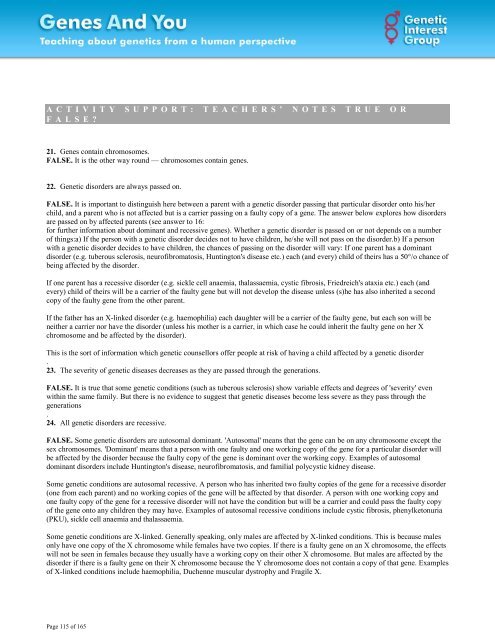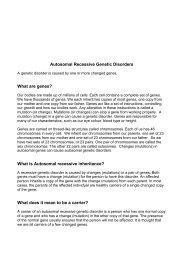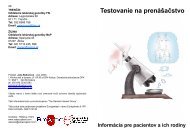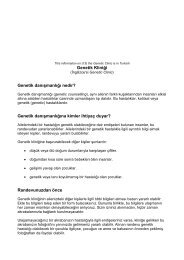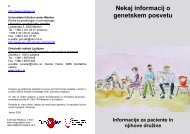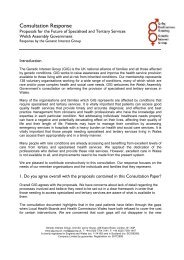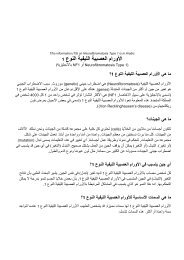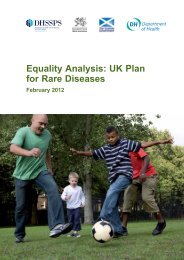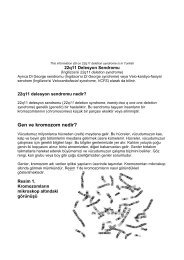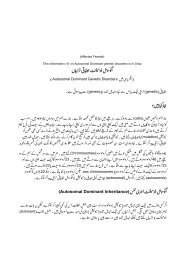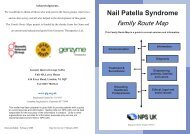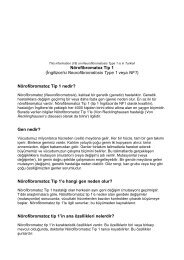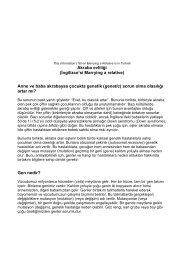TRUE OR FALSE? - Genetic Alliance UK
TRUE OR FALSE? - Genetic Alliance UK
TRUE OR FALSE? - Genetic Alliance UK
You also want an ePaper? Increase the reach of your titles
YUMPU automatically turns print PDFs into web optimized ePapers that Google loves.
A C T I V I T Y S U P P O R T : T E A C H E R S ’ N O T E S T R U E O R<br />
F A L S E ?<br />
21. Genes contain chromosomes.<br />
<strong>FALSE</strong>. It is the other way round — chromosomes contain genes.<br />
22. <strong>Genetic</strong> disorders are always passed on.<br />
<strong>FALSE</strong>. It is important to distinguish here between a parent with a genetic disorder passing that particular disorder onto his/her<br />
child, and a parent who is not affected but is a carrier passing on a faulty copy of a gene. The answer below explores how disorders<br />
are passed on by affected parents (see answer to 16:<br />
for further information about dominant and recessive genes). Whether a genetic disorder is passed on or not depends on a number<br />
of things:a) If the person with a genetic disorder decides not to have children, he/she will not pass on the disorder.b) If a person<br />
with a genetic disorder decides to have children, the chances of passing on the disorder will vary: If one parent has a dominant<br />
disorder (e.g. tuberous sclerosis, neurofibromatosis, Huntington's disease etc.) each (and every) child of theirs has a 50°/o chance of<br />
being affected by the disorder.<br />
If one parent has a recessive disorder (e.g. sickle cell anaemia, thalassaemia, cystic fibrosis, Friedreich's ataxia etc.) each (and<br />
every) child of theirs will be a carrier of the faulty gene but will not develop the disease unless (s)he has also inherited a second<br />
copy of the faulty gene from the other parent.<br />
If the father has an X-linked disorder (e.g. haemophilia) each daughter will be a carrier of the faulty gene, but each son will be<br />
neither a carrier nor have the disorder (unless his mother is a carrier, in which case he could inherit the faulty gene on her X<br />
chromosome and be affected by the disorder).<br />
This is the sort of information which genetic counsellors offer people at risk of having a child affected by a genetic disorder<br />
.<br />
23. The severity of genetic diseases decreases as they are passed through the generations.<br />
<strong>FALSE</strong>. It is true that some genetic conditions (such as tuberous sclerosis) show variable effects and degrees of 'severity' even<br />
within the same family. But there is no evidence to suggest that genetic diseases become less severe as they pass through the<br />
generations<br />
.<br />
24. All genetic disorders are recessive.<br />
<strong>FALSE</strong>. Some genetic disorders are autosomal dominant. 'Autosomal' means that the gene can be on any chromosome except the<br />
sex chromosomes. 'Dominant' means that a person with one faulty and one working copy of the gene for a particular disorder will<br />
be affected by the disorder because the faulty copy of the gene is dominant over the working copy. Examples of autosomal<br />
dominant disorders include Huntington's disease, neurofibromatosis, and familial polycystic kidney disease.<br />
Some genetic conditions are autosomal recessive. A person who has inherited two faulty copies of the gene for a recessive disorder<br />
(one from each parent) and no working copies of the gene will be affected by that disorder. A person with one working copy and<br />
one faulty copy of the gene for a recessive disorder will not have the condition but will be a carrier and could pass the faulty copy<br />
of the gene onto any children they may have. Examples of autosomal recessive conditions include cystic fibrosis, phenylketonuria<br />
(PKU), sickle cell anaemia and thalassaemia.<br />
Some genetic conditions are X-linked. Generally speaking, only males are affected by X-linked conditions. This is because males<br />
only have one copy of the X chromosome while females have two copies. If there is a faulty gene on an X chromosome, the effects<br />
will not be seen in females because they usually have a working copy on their other X chromosome. But males are affected by the<br />
disorder if there is a faulty gene on their X chromosome because the Y chromosome does not contain a copy of that gene. Examples<br />
of X-linked conditions include haemophilia, Duchenne muscular dystrophy and Fragile X.<br />
Page 115 of 165


